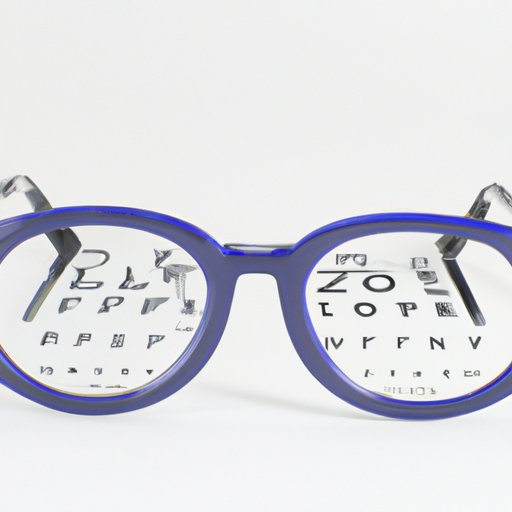
Introduction
Have you ever had trouble understanding your eyeglasses prescription? You’re not alone. Many people find it difficult to interpret the numbers, abbreviations, and symbols that appear on their prescription from the optometrist. However, understanding your glasses prescription is key to ensuring you get the right lenses to correct your vision. This beginner’s guide is here to help you decode and navigate your eyeglasses prescription.
A Beginner’s Guide to Understanding Your Glasses Prescription
At a basic level, a glasses prescription is a written order from your optometrist outlining the lenses you need to correct your vision. The prescription provides information on the strength and characteristics of your lenses, such as their power and curvature.
There are three main components to any glasses prescription – power, cylinder, and axis. Power refers to the strength of your lenses and is measured in diopters. Cylinder and axis measurements apply only to those with astigmatism – a condition where the cornea is misshapen, causing blurry vision. The cylinder value measures the amount of astigmatism, and the axis value provides information about the direction of the astigmatism.
There are several types of lenses available, including single vision, bifocal, and progressive lenses. Single vision lenses are designed to correct either nearsightedness or farsightedness, while bifocal lenses have two prescriptions in one lens to correct for both near and distance vision. Progressive lenses, also known as multifocal lenses, are similar to bifocals but have a gradual change in prescription to provide a smoother transition between distances.
Unlocking the Code: How to Read Your Eyeglass Prescription
Reading your eyeglass prescription might seem daunting at first, but breaking it down into parts can make it easier to understand. The first thing to look for is the power of your lenses, which is indicated by a number followed by the abbreviation ‘D’ for diopters. A negative number indicates nearsightedness, while a positive number indicates farsightedness.
If you have astigmatism, you’ll also see a cylinder value, which indicates the amount of astigmatism correction needed. This is followed by an axis value, which indicates the orientation of the cylinder. Axis values are usually expressed in degrees, from 0 to 180.
There may also be additional abbreviations and symbols on your prescription, such as PD (pupillary distance), which measures the distance between your pupils. Other symbols include OU (both eyes), OS (left eye), and OD (right eye).
Step-by-Step: Navigating Your Eyeglass Prescription
To understand your eyeglass prescription fully, it’s important to know how to navigate each section. The power value is the most critical part of your prescription, indicating whether you are nearsighted or farsighted and the strength of the lenses you need.
The cylinder and axis values are important if you have astigmatism, as they provide information about the orientation and magnitude of astigmatism. Make sure you pay attention to these values to ensure that you get lenses that correct your astigmatism properly.
It’s also a good idea to consider add-on options, such as anti-glare or scratch-resistant coatings, which can help improve your vision quality and prolong the life of your lenses.
From Spheres to Values: Decoding Your Glasses Prescription
Your glasses prescription contains several different numbers, symbols, and abbreviation. Spheres are used to indicate the power of your lenses, with negative values indicating nearsightedness and positive values indicating farsightedness. Cylinder and axis values are used to correct astigmatism, providing information about the orientation and magnitude of any lens astigmatism correction needed.
Some other values you may encounter include prism, which can be used to correct a muscle imbalance in your eyes, and base curve, which describes the curvature of the lens and is used to ensure a comfortable and appropriate fit.
The Ultimate Guide to Understanding Your Glasses Prescription
This guide has provided an overview of the key points to consider when interpreting and understanding your glasses prescription. It’s important to remember that your eyeglass prescription is unique to you, and no one else’s prescription will be identical to yours.
In addition to understanding the technical aspects of your prescription, it is also essential to talk with your optometrist about any concerns or questions you have. Your optometrist will be able to help you customize your prescription recommendations to your specific needs and explain anything that is unclear.
Reading Between the Lines: Interpreting Your Eyeglass Prescription
When interpreting your eyeglass prescription, it’s essential to consider the intent behind your prescription and how it is designed to correct your vision. If your prescription seems to be confusing or unclear, don’t hesitate to ask your optometrist for guidance.
Customizing your prescription can also help ensure that it meets your specific needs. For example, if you spend a lot of time reading or using a computer, you may need different prescriptions for your near and distance vision.
Demystifying Your Glasses Prescription: A Simple Guide for Beginners
Knowing how to read and interpret your eyeglass prescription can be daunting, but this guide has hopefully demystified the process and made it easier to understand. Remember, your prescription is unique to you, so it’s essential to work closely with your optometrist to ensure that you get the right lenses and treatment for your vision correction needs.
Conclusion
Understanding and interpreting your glasses prescription can be challenging, but it’s an essential step in taking control of your vision health. By breaking down the different components of your prescription and understanding what each value and symbol means, you can ensure that you get the right lenses to correct your vision. As always, if you have any questions or concerns about your prescription, don’t hesitate to ask your optometrist.





